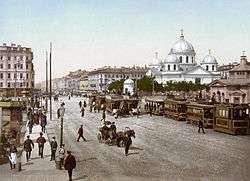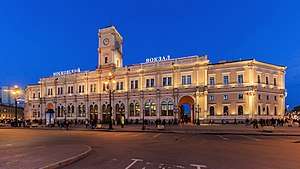Vosstaniya Square
Vosstaniya Square (Russian: Пло́щадь Восста́ния, lit. Uprising Square) is a major square in the Central Business District of Saint Petersburg, Russia. The square lies at the crossing of Nevsky Prospekt, Ligovsky Prospekt, Vosstaniya Street and Goncharnaya Street, in front of the Moskovsky Rail Terminal, which is the northern terminus of the line connecting the city with Moscow. Administratively, the Vosstaniya Square falls under the authority of the Tsentralny District.

History
From the 1840s to 1918 the square was known as Znamenskaya Square (Russian: Знаменская площадь, "Sign Square"), after the Church of the Sign built there between 1794 and 1804 to a Neoclassical design by Fyodor Demertsov. The church building commemorated the icon of Our Lady of the Sign.
Four years before the Romanov Tercentenary, in 1909, Prince P. P. Trubetskoy completed a tremendous equestrian statue of Tsar Alexander III. It stood opposite Nikolayevsky Station in Znamenskaya Square. Even members of the imperial family ridiculed the statue; after the revolution the Bolsheviks left it in place as a powerful and formidable representation of the autocracy until the 1930s, when it was removed. It remained in storage for fifty years before re-erection in 1994 in front of the Marble Palace (formerly the Leningrad branch of the Lenin Museum), on the former site of the armoured car that had transported Lenin from the Finland Station on 16 April [O.S. 3 April] 1917.[1]
The square was a scene of many revolutionary demonstrations and protests. After the Bolsheviks took control of Petrograd in 1917, they had the square renamed (1918) into Uprising Square (literally: "Square of the Uprising") to commemorate these events. The Church of the Sign was demolished in 1940 to make room for the surface vestibule of the Ploshchad Vosstaniya (Vosstaniya Square) metro-station (opened in 1955).
The Leningrad Hero-City Obelisk - designed by architects Vladimir Lukyanov and Aleksandr I. Alymov - was erected on the same spot in 1985 in order to commemorate the 40th anniversary of Victory Day.
In 2010 the 200,000-square-metre (2,200,000 sq ft) Galereya shopping center opened on the square, including a large Stockmann department store.[2]
Transport hub
The Vosstaniya Square is a major traffic hub of Saint Petersburg. It is home to the large Moscow Rail Terminal, from where trains depart for Moscow, Novosibirsk and other major cities, it is filled with passengers every day.
The square is home to the metro station Ploshchad Vosstaniya. The square is also a main hub for marshrutkas, taxis, buses, trolleybuses and trams.
 View of Nevsky Prospekt from Znamenskaya Square in the 1890s
View of Nevsky Prospekt from Znamenskaya Square in the 1890s The Church of the Sign on Znamenskaya Square (built in 1794-1804)
The Church of the Sign on Znamenskaya Square (built in 1794-1804)- Vosstania Square and Oktyabrskaya hotel
 Moscow Rail Terminal
Moscow Rail Terminal- Metro station Ploshchad Vosstaniya
See also
References
| Wikimedia Commons has media related to Vosstaniya Square. |
-
Figes, Orlando (1997). A people's tragedy: a history of the Russian Revolution. Viking. p. 15. Retrieved 2016-09-12.
Four years before the tercentenary the brilliant sculptor, Prince P. N. Trubetskoi, had completed an equestrian statue of the former Tsar Alexander III which stood in Znamenskaya Square opposite the Nikolaevsky Station in St Petersburg. It was such an ingenious and formidable representation of autocracy in human form that after the revolution the Bolsheviks decided to leave it in place [...]. [...] the horse now stands in front of the former Lenin Museum
- "Grand opening for Galeria Mall, St Petersburg", Mace, December 3, 2010